Bhubaneswar - Ratnagiri - Udayagiri - Lalitgiri - Langudi Hills - Pipli - Puri – Konarak - Fishermen’s village - Kuruma - Mangalajodi - Gopalpur - Chandragiri - Vishakapatnam
Odisha formerly known as Orissa is a wonderful land of fascinating beauty situated on the East coast along the Bay of Bengal and is endowed with nature’s bounty, a 482kms stretch of coastline encompassed by the forest clad blue hills of Eastern Ghats.
The history of Orissa, which acquired indelible fame and glory under its past names, Kalinga, Utkal or Odradesha dates back to very remote antiquity. The State was known, far and wide, for the heroic deeds and cultural upheavals, maritime trade and over-sea expansion of its people. It is now a locus of traditions, customs, ethnic and tribal groups that can be traced back to the stone ages. This unique and exotic state is the only one of its kind in India, and one of the few in the world.
In the sphere of religion and philosophy - Tribal and Aryan religions, Buddhism and Jainism, Islam and Christianity all have existed in history and they continue side by side even now as a testimony to the religious tolerance of the people of this land.
In art and architecture, centuries of history survive in the shape of temples and even today they survive in replicas, which provide livelihood to the descendants of the ancient practitioners of these arts. The most revered Lord Lingaraj Temple overlooks the temple complex of Bhubaneswar dotted as it is with temples – big, small, ancient and in cluster. The most holy of them all is the Lord Jagannath Temple in Puri also magnified as The Lord of the Universe. The Black Pagoda at Konark is a colossal Divine chariot of the Sun God. The outstanding contributions of Orissa towards the Buddhist culture are also uncountable. In past Buddhism occupied a great position in religious history of Orissa. Lord Buddha is indeed rightly said the light of Asia. The monastic ruins of the Diamond Triangle of Ratnagiri, Lalitagiri and Udaygiri are mute witnesses of our marvelous past.
Come to this captivating land to experience the exotic feeling of the wonderful scenic, serene, sublime Odisha!
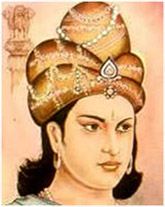 King Aśoka and Buddhism
King Aśoka and Buddhism
King Aśoka, the third monarch of the Mauryan dynasty in the third century B.C., was the first ruler of a unified India and one of the greatest political figures of all time. After he embraced the teachings of the Buddha, he transformed his polity from one of military conquest to one of Dharmavijaya — victory by righteousness and truth. By providing royal patronage for the propagation of Buddhism both within and beyond his empire, he helped promote the metamorphosis of Buddhism into a world religion that spread peacefully across the face of Asia.
Meet and assist on arrival at Bhubaneswar Airport in the morning and transfer to Hotel.
Later visit Dhauli.
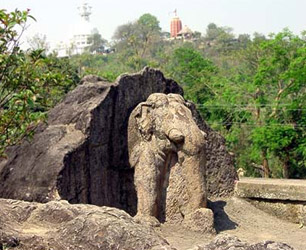 Ashoka (reign ca. 272-231 BC) was the most illustrious king of the Maurya dynasty. After his conquest of the kingdom of Kalinga in modern day Orissa, struck with remorse at the suffering he caused, Ashoka converted to Buddhism and spent the rest of his life propagating his dharma (law). In order to achieve this, he had numerous edicts inscribed on rocks, pillars and caves, throughout his vast empire. These are written in various vernaculars and represent the earliest written document from the Indic regions. From these edicts it would appear clear that Ashoka was an extremely tolerant and benevolent monarch. Near Dhauli, south of Bhubaneshwar, there is a rock inscribed with the edicts of the emperor Ashoka. The front of the rock is sculpted as the head, trunk and front legs of an elephant.
Ashoka (reign ca. 272-231 BC) was the most illustrious king of the Maurya dynasty. After his conquest of the kingdom of Kalinga in modern day Orissa, struck with remorse at the suffering he caused, Ashoka converted to Buddhism and spent the rest of his life propagating his dharma (law). In order to achieve this, he had numerous edicts inscribed on rocks, pillars and caves, throughout his vast empire. These are written in various vernaculars and represent the earliest written document from the Indic regions. From these edicts it would appear clear that Ashoka was an extremely tolerant and benevolent monarch. Near Dhauli, south of Bhubaneshwar, there is a rock inscribed with the edicts of the emperor Ashoka. The front of the rock is sculpted as the head, trunk and front legs of an elephant.
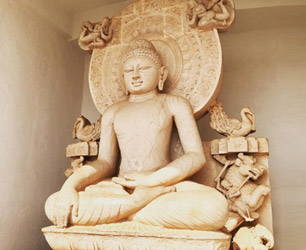 The Shanti Stupa at Dhauli Hills is a significant symbol of love and peace. The pilgrimage is significant because here King Ashoka resigned from violent wars. After witnessing the devastating sight of blood filled land and the Daya River that obtained red color because of the merciless slaughter of around 1,50, 000 warriors, King Ashoka was filled with sheer grief and therefore decided to renounce wars completely all through the rest of his life. It is at Dhauli that Ashoka resorted to Buddhism and presented his sword in front of Lord Buddha.
The Shanti Stupa at Dhauli Hills is a significant symbol of love and peace. The pilgrimage is significant because here King Ashoka resigned from violent wars. After witnessing the devastating sight of blood filled land and the Daya River that obtained red color because of the merciless slaughter of around 1,50, 000 warriors, King Ashoka was filled with sheer grief and therefore decided to renounce wars completely all through the rest of his life. It is at Dhauli that Ashoka resorted to Buddhism and presented his sword in front of Lord Buddha.
Overnight at Hotel – Bhubaneswar.
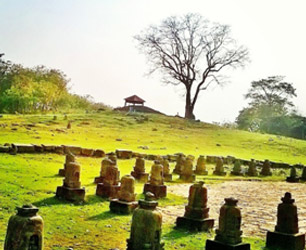 Day 2: Bhubaneswar- Ratnagiri - Udayagiri – 95kms /2 hours
Day 2: Bhubaneswar- Ratnagiri - Udayagiri – 95kms /2 hours
After breakfast proceed to visit the Diamond Triangle of Odisha. These three hills and their environs comprise a remarkable Buddhist complex. HiuenT’sang the Chinese Pilgrim found it to be the seat of a flourishing Buddhist University called Puspagiri. Extensive ruins of brick pagodas, sculptured stone portals and esoteric Buddhist images testifying is ancient glory, have been unearthed. Discover the trails of Buddhism!
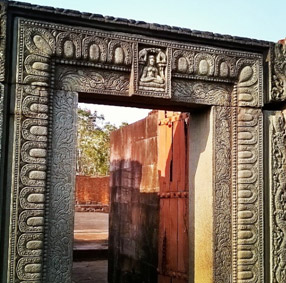 RATNAGIRI: By the river Birupa, about 100 kms. away from Bhubaneswar, Ratnagiri has a rich concentration of Buddhist antiquities. A large excavation has unearthed Buddhist shrines, large monasteries, a big stupa and a number of vovite stupas. Established way back in 6th century AD., it appears that Buddhism was fostered at this place unhindered up to the 12th century AD. ASI Museum at Ratnagiri (This Museum is closed on Fridays and local state holidays but the excavated site is open always and can be visited ).
RATNAGIRI: By the river Birupa, about 100 kms. away from Bhubaneswar, Ratnagiri has a rich concentration of Buddhist antiquities. A large excavation has unearthed Buddhist shrines, large monasteries, a big stupa and a number of vovite stupas. Established way back in 6th century AD., it appears that Buddhism was fostered at this place unhindered up to the 12th century AD. ASI Museum at Ratnagiri (This Museum is closed on Fridays and local state holidays but the excavated site is open always and can be visited ).
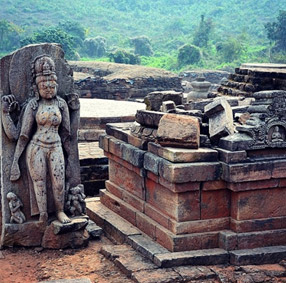 UDAYAGIRI: Nearby Udayagiri is known for its bell-shaped stupa signifying Vajrajana from of Buddhism. One of the largest Buddhist complexes in Odisha, Udayagiri is about 90 kms. away from Bhubaneswar. The ancient name of this complex was MadhavapuraMahavihara. Chronologically, this complex came in to being after Ratnagiri and Lalitgiri, flourishing between 7th and 12th century AD. It is located in the basin of a U-shaped hill. The remains suggest the presence of brick monastery, a brick stupa, rock-cut sculptures and a sepped well with an inspiration.
UDAYAGIRI: Nearby Udayagiri is known for its bell-shaped stupa signifying Vajrajana from of Buddhism. One of the largest Buddhist complexes in Odisha, Udayagiri is about 90 kms. away from Bhubaneswar. The ancient name of this complex was MadhavapuraMahavihara. Chronologically, this complex came in to being after Ratnagiri and Lalitgiri, flourishing between 7th and 12th century AD. It is located in the basin of a U-shaped hill. The remains suggest the presence of brick monastery, a brick stupa, rock-cut sculptures and a sepped well with an inspiration.
Overnight at Toshali Ratnagiri.
After breakfast visit of Lalitgiri,Langudihills and nearby local villages.
 LALITGIRI: Lalitgiri, 12 kms away from Ratnagiri, is one of the earliest Buddhist complexes, dating back to the 1st century AD. The huge brick monastery, the remains of a Chaitya Hall, a number of votive stupas and a renovated stone stupa at the top of a rugged standtone hillock dominate the greenery around. The sculpture shed nearby displays excavated images, throwing light on the various schools of Buddhist art.
LALITGIRI: Lalitgiri, 12 kms away from Ratnagiri, is one of the earliest Buddhist complexes, dating back to the 1st century AD. The huge brick monastery, the remains of a Chaitya Hall, a number of votive stupas and a renovated stone stupa at the top of a rugged standtone hillock dominate the greenery around. The sculpture shed nearby displays excavated images, throwing light on the various schools of Buddhist art.
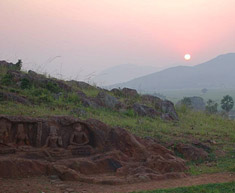 LANGUDI HILLSs -Langudi hill was a prominent Buddhist seat of learning that flourished until the 11th century in India. This Buddhist archaeological site embellished with series of rock-cut Buddhist stupas and several early medieval Buddhist monuments and shrines. At Langudi hills the ruins of a brick stupa and a large monastery still exist. All in all, the Buddhist remains on the hill indicate that Langudi was a significant centre of the Hinayana, Mahayana and Vajrayana sects of Buddhism
LANGUDI HILLSs -Langudi hill was a prominent Buddhist seat of learning that flourished until the 11th century in India. This Buddhist archaeological site embellished with series of rock-cut Buddhist stupas and several early medieval Buddhist monuments and shrines. At Langudi hills the ruins of a brick stupa and a large monastery still exist. All in all, the Buddhist remains on the hill indicate that Langudi was a significant centre of the Hinayana, Mahayana and Vajrayana sects of Buddhism
Overnight at Toshali Ratnagiri.
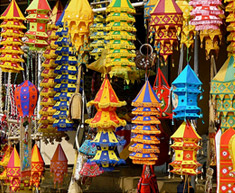 Day 4: Ratnagiri – Pipli-Puri 150kms/ 3.5 hours
Day 4: Ratnagiri – Pipli-Puri 150kms/ 3.5 hours
After breakfast leave for Puri enroute visiting Pipli appliqué village.
Pipli – It’sa centre for appliqué work, which depicts the essence of Oriya culture. It is also known for colorful and original awnings, canopies, garden and beach umbrellas, shoulder and handbags etc. The cocktail effect of the colors is certainly a feast for the eyes. Pipli, Orissa's appliqué capital, announces itself with loud colorful splashes of bright colour in the shop fronts.
Arrive Puri and check into Hotel. All hotels in Puri has check-in/check-out at 08:00 hrs
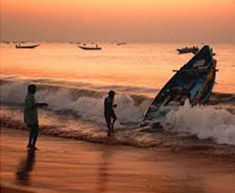 Afternoon visit of Puri Jagannath temple and beach.
Afternoon visit of Puri Jagannath temple and beach.
For centuries now, the beach at Puri has been the venue of countless pilgrims taking the traditional purifying dip. However, for decades now, both Indian and foreign beach lovers have made it their special haunt. The fine golden sands of Puri beach and the roar of the breakers rolling in from the Bay of Bengal have fascinated visitors throughout the ages. As it is with all the beaches of Odisha, overcrowding is never a problem and the sight of holiday-makers having entire stretch of the beach to them is not uncommon. The local fishermen, with their catamarans and wide brimmed cane hats are welcomed by tourists.
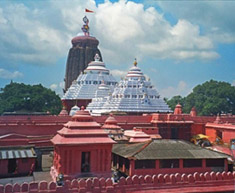 The Jagannath Temple at Puri which is one of the most sacred pilgrimage spots in India. This 12th century temple is dedicated to Lord Jagannath –“The Lord of the Universe”. The wooden figures of the three deities, Jagannath, Balabhadra and Subhadra stand in the sanctorium garlanded and decorated by the high priests. The extraordinary form that Jagannath takes, according to the legend, is the unfinished work of the craftsman god Viswakarma, who in anger left this portrayal of Lord Vishnu incomplete. This majestic temple and its chronicles allure devotees from all over the world. The wide BadaDanda, the road which leads up to the majestic temple, provides a view of the grandness of scale and proportion that typifies Puri. This is also the path to Nirvana, where the chariots of the much-loved divine siblings, Jagannath, Subhadra and Balabhadra, roll down in the famous annual Rath Yatra, which inspires awe and draws tumultuous crowds. In Puri, everything has to be big. The main road is called BadaDanda, or Grand Road; the sea is Mahodadhi, or the widest ocean; the bhog is called Mahaprasad, or the great prasad.
The Jagannath Temple at Puri which is one of the most sacred pilgrimage spots in India. This 12th century temple is dedicated to Lord Jagannath –“The Lord of the Universe”. The wooden figures of the three deities, Jagannath, Balabhadra and Subhadra stand in the sanctorium garlanded and decorated by the high priests. The extraordinary form that Jagannath takes, according to the legend, is the unfinished work of the craftsman god Viswakarma, who in anger left this portrayal of Lord Vishnu incomplete. This majestic temple and its chronicles allure devotees from all over the world. The wide BadaDanda, the road which leads up to the majestic temple, provides a view of the grandness of scale and proportion that typifies Puri. This is also the path to Nirvana, where the chariots of the much-loved divine siblings, Jagannath, Subhadra and Balabhadra, roll down in the famous annual Rath Yatra, which inspires awe and draws tumultuous crowds. In Puri, everything has to be big. The main road is called BadaDanda, or Grand Road; the sea is Mahodadhi, or the widest ocean; the bhog is called Mahaprasad, or the great prasad.
(Non Hindus are not allowed inside the Jagannath temple and to be viewed from Raghunathan library platform. Sunday this platform is closed but one can walk along the holy streets and interact with the local community)
Overnight at Hotel- Puri.
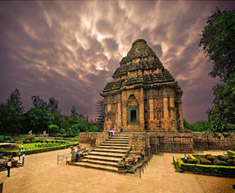 Day 5: Puri – Konarak- Fishermen’s village- -Kuruma-Puri – 110 kms/2.5hrs
Day 5: Puri – Konarak- Fishermen’s village- -Kuruma-Puri – 110 kms/2.5hrs
After breakfast excursion to visit the famous Sun Temple at Konarak and visit of local fishermen village
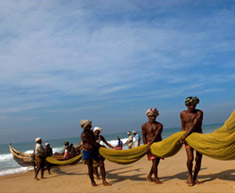 Konark - The third link in the Orissan Golden Triangle, Konark is the site of one of the most spectacular examples of religious architecture in the world. The Sun Temple at Konark conceived as a massive chariot hauling the Sun God across the heavens by the might of seven splendidly carved horses, standing aloft on 24 chariot wheels-intricately carved - symbolizing the march of time, lies in solitary splendor surrounded by drifting sand three kilometres from the sea, but originally it was reported to be closer for which it was used as a navigational point by European sailors, who referred to it as the 'Black Pagoda'. This 13th century architectural marvel is one of the most magnificent monuments of the World and also a UNESCO World Heritage site. Nobel Laureate & Poet Rabindranath Tagore said, 'here the language of stone surpasses the language of man'. It is true that the experience of Konark is impossible to translate into words. Also visit the local Fishermans village and interact with the local community.
Konark - The third link in the Orissan Golden Triangle, Konark is the site of one of the most spectacular examples of religious architecture in the world. The Sun Temple at Konark conceived as a massive chariot hauling the Sun God across the heavens by the might of seven splendidly carved horses, standing aloft on 24 chariot wheels-intricately carved - symbolizing the march of time, lies in solitary splendor surrounded by drifting sand three kilometres from the sea, but originally it was reported to be closer for which it was used as a navigational point by European sailors, who referred to it as the 'Black Pagoda'. This 13th century architectural marvel is one of the most magnificent monuments of the World and also a UNESCO World Heritage site. Nobel Laureate & Poet Rabindranath Tagore said, 'here the language of stone surpasses the language of man'. It is true that the experience of Konark is impossible to translate into words. Also visit the local Fishermans village and interact with the local community.
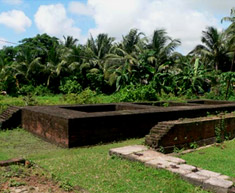 The ancient Buddhist site of Kuruma is situated 8 kms to the south-east of the famous Sun Temple at Konark in the district of Puri. On the top portion of the very site there is a modern temple which houses three Buddhist images viz. crowned Buddha seated in Bhumisparsa mudra, PadmapaniAvalokitesvara and Revanta. These three images are jointly worshipped as 'Yamadharma' by local inhabitants. Because of the close proximity of the famous Sun Temple at Konark, it is an important site from tourism point of view.
The ancient Buddhist site of Kuruma is situated 8 kms to the south-east of the famous Sun Temple at Konark in the district of Puri. On the top portion of the very site there is a modern temple which houses three Buddhist images viz. crowned Buddha seated in Bhumisparsa mudra, PadmapaniAvalokitesvara and Revanta. These three images are jointly worshipped as 'Yamadharma' by local inhabitants. Because of the close proximity of the famous Sun Temple at Konark, it is an important site from tourism point of view.
Overnight at Hotel- Puri.
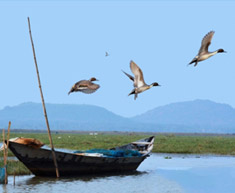 Day 6: Puri – Mangalajodi-Gopalpur-On Sea –210 kms/ 4.5 hrs
Day 6: Puri – Mangalajodi-Gopalpur-On Sea –210 kms/ 4.5 hrs
After breakfast drive to Gopalpur enroute visiting Chilika Lake-Mangalajodi community village.
Mangalajodi, Chilka Lake- A vast lake along the eastern cost of Odisha with beautiful islands, flamingoes wading in the shallow waters and the air echoing with the chirping of birds from as far as the Caspian Sea, Aral Sea and other parts of Mongolia, Central and South-East Asia, that’s the breath-taking beauty of Chilika-Asia’s largest brackish water estuarine lake. Chilika sprawls over an area of 1100 sq.km covering parts of three districts of Odisha i.e. Puri on the east, Khurdha on the North and Ganjam on the South. It’s a haven for bird-watchers / nature lovers. Abounding in unique flora and fauna, Chilika supports the livelihood of more than hundred thousand families living in and around it. Winter is the best time to visit Chilika as over 160 species of migratory birds flock the islands during this time of the year.
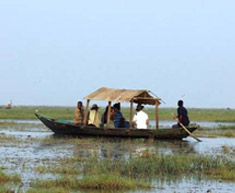 A community owned and managed wildlife conservation venture, Mangalajodi Ecotourism is your destination to get a peep into Mother Nature. Mangalajodi is a village located on the northern banks of Chilika Lake in Odisha, ‘The Bird’s Paradise’ hosts more than 3,00,000 birds in its marshy waters, especially in winters. Mangalajodi also represents one of its kind ecosystems, whose protection is epitomised by a sustainable lifestyle that is at a brink of extinction in urban settings.
A community owned and managed wildlife conservation venture, Mangalajodi Ecotourism is your destination to get a peep into Mother Nature. Mangalajodi is a village located on the northern banks of Chilika Lake in Odisha, ‘The Bird’s Paradise’ hosts more than 3,00,000 birds in its marshy waters, especially in winters. Mangalajodi also represents one of its kind ecosystems, whose protection is epitomised by a sustainable lifestyle that is at a brink of extinction in urban settings.
Enjoy a country boat ride at Mangalajodi .Also visit the Mangalajodi village and interact with the fishing families. Visit of JaugadaAshokan Rock edict.
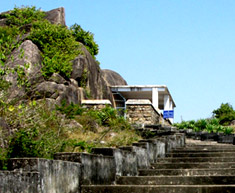 The place is of great historical importance as one of the famous rock edicts of Ashoka, the great Maurya is located here. Jaugada stands as the symbol of all the historical heritage connected with the Rushikulya Valley Civilization. The Jaugada inscription is engraved on three different tablets on three vertical face of a picturesque granite rock of the Khapingala hills protected by an enclosure. It is inscribed in Prakrit language and Brahmi script. The two special Rock Edicts were inscribed in the form of instructions to the Mahamatras to be impartial and conciliatory to the people, and promulgated the principles on which Ashoka sought to base the administration of Kalinga and its bordering tribes. The separate Kalinga Edicts, infact, are meant for the people of Kalinga and are not found elsewhere.
The place is of great historical importance as one of the famous rock edicts of Ashoka, the great Maurya is located here. Jaugada stands as the symbol of all the historical heritage connected with the Rushikulya Valley Civilization. The Jaugada inscription is engraved on three different tablets on three vertical face of a picturesque granite rock of the Khapingala hills protected by an enclosure. It is inscribed in Prakrit language and Brahmi script. The two special Rock Edicts were inscribed in the form of instructions to the Mahamatras to be impartial and conciliatory to the people, and promulgated the principles on which Ashoka sought to base the administration of Kalinga and its bordering tribes. The separate Kalinga Edicts, infact, are meant for the people of Kalinga and are not found elsewhere.
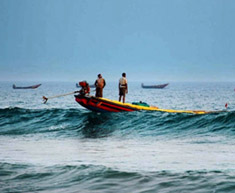 Later proceed to Gopalpur
Later proceed to Gopalpur
Gopalpur – On-Sea which is a sleepy hamlet that betrays no traces of its glorious past. The ruins of an old port speak of a time that won Gopalpur its prominent place in Odisha’s history. You can forget yourself at Gopalpur and have a lovely, lazy holiday. This virgin beach with coconut groves, casuarina coppices and gentle sand dunes is deserted for miles and perfect for an ultimate relaxation to prepare you for your adventurous tribal trail ahead.
Even prior to the British era, Gopalpur was a maritime hub under the Kalingas, only then it was known by another name, Mansurkota.The British renamed it Gopalpur after an 18th century temple dedicated to Lord Krishna. During the British Raj too, Gopalpur-on-sea was a vibrant sea port from where trade activities were carried out. Rice, silk and pearls found their way to and fro Burma, Sumatra and Bali. As a result of these activities, Gopalpur became quite a happening place and enjoyed a reputation of being a pleasure resort where dance and parties was a regular feature. This was patronized by the British and the wealthy Bengalis. The ruins of a jetty still invoke nostalgia of an era gone by.
Overnight at Hotel- Gopalpur-On-Sea.
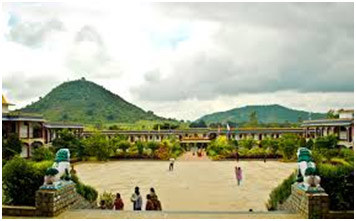 Day 7: Gopalpur-On Sea – Chandragiri-Gopalpur-On-Sea 210 kms/ 4 hrs
Day 7: Gopalpur-On Sea – Chandragiri-Gopalpur-On-Sea 210 kms/ 4 hrs
After breakfast excursion to Chandragiri to visit PadmasambhavaMahavihara Monastery & Temple and interaction with the resident monks and the local community.
 The PadmasambhavaMahavihara monastery, located at Chandragiri, Gajapati district, in the state of Orissa, India, is the largest Buddhist monastery in South Asia. It was inaugurated by the Dalai Lama in January 2010. It was built in the Atanpuri style of architecture of Nalanda by architects from Tibet, Nepal and Bhutan assisted by local masons. It is 70 feet (21 m) and five stories high, and is built on 10 acres (40,000 m2) of land. It features a 23 feet (7.0 m) high Buddha statue and 17 feet (5.2 m) Buddha Padmasambhava. 200 monks are resident in the monastery, which is named after Acharya Padmasambhava who was born in Orissa and who is believed to have spread Buddhism to Tibet in the 7th Century.
The PadmasambhavaMahavihara monastery, located at Chandragiri, Gajapati district, in the state of Orissa, India, is the largest Buddhist monastery in South Asia. It was inaugurated by the Dalai Lama in January 2010. It was built in the Atanpuri style of architecture of Nalanda by architects from Tibet, Nepal and Bhutan assisted by local masons. It is 70 feet (21 m) and five stories high, and is built on 10 acres (40,000 m2) of land. It features a 23 feet (7.0 m) high Buddha statue and 17 feet (5.2 m) Buddha Padmasambhava. 200 monks are resident in the monastery, which is named after Acharya Padmasambhava who was born in Orissa and who is believed to have spread Buddhism to Tibet in the 7th Century.
Overnight at Hotel- Gopalpur-On-Sea.
 Day 8: Gopalpur-On Sea – Vishakapatnam 320kms/ 5.5 hrs
Day 8: Gopalpur-On Sea – Vishakapatnam 320kms/ 5.5 hrs
Following breakfast drive to Vishakapatnamen-route visit ofSailhundam and Kalingapatnam.
Andhra Pradesh, also known as Andhra Desam, is known for its rich cultural ethos and heritage that encompasses several heritages of other Indian States. Why so? Several dynasties made spectacular contributions in the field of art, culture including architecture, music etc. and this has definitely enhanced the image of the Andhra Pradesh not only nationally but also globally.
Salihundam, on the right bank of the river Vamsadhara, about 116 kms from Visakhapatnam, in the Srikakulam district, there are a number of Buddhist stupas and huge monastic complex on a hillock amidst scenic surroundings.You can see Maha Stupa, Votive Stupas, Platforms and Viharas.There's distinct evidence of the presence of the Vajrayana cult.From here, Buddhism spread to Sumatra and other Far-Eastern countries.
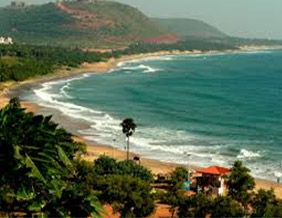 Kalingapatnam was an old European Trading post used by the British East India Company. There is a tall light house that yields a beautiful view of the ocean. Close to the beach are excavations of Buddhist relics that are similar to that found in Salihundam.
Kalingapatnam was an old European Trading post used by the British East India Company. There is a tall light house that yields a beautiful view of the ocean. Close to the beach are excavations of Buddhist relics that are similar to that found in Salihundam.
Vishakhapatnam - The crest of natural beauty of Andhra Pradesh. Located in the north of the coastal part of the State, the district and surrounding areas have some of the most fascinating places that one would love to visit. Vishakapatnam, originally a small fishing village, is one of the biggest ports in the country housed in a natural harbour with a picturesque hill resembling a dolphin, aptly named Dolphin’s nose, forming the recess.
Overnight at Hotel – Vishakapatnam.
 Day 9: Vishakapatnam
Day 9: Vishakapatnam
After breakfast explore the city of Vishakhapatnam
A verdant hill on the northern side of the city, the Kalasagiri Hill offers spectacular views of the winding shoreline and undulated cityscape. Of the 100 acres available on the hilltop, 50 acres have been developed into a beautiful park. Located at an altitude of 130 meters, this hill top park faces the Bay of Bengal and is a very popular among tourists and picnickers. It has seven viewpoints, which enable visitors to enjoy the ambient beauty. The main attractions include Siva Parvathi Statue, Shanku Chakra Naama, Ropeway to the hill, Art Gallery, Floral Clock, Jungle Trails, Food Courts, Seven Wonders of Vizag, Siva Temple, Titanic Viewpoint, Shanti Ashram, Road Train, Gliding Base Point, Children’s Play Park, Conference Hall and the Capsule Lift.
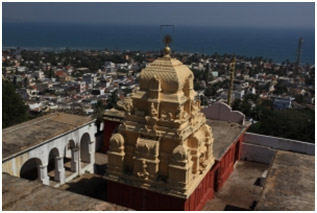 The 25 Kms stretch of road literally hugging the coastline from Visakhapatnam is simply breathtaking. Bheemili a sleepy little town, is the second oldest municipality in the country. The colonial past of the town is evident in the remains of a once thriving Dutch Settlement. River Gosthani at the mouth of which Bheemili lies forms an alluring recess to the town. The important landmarks of Bheemili includes, pilgrimage centers, temples, old churches, clock tower, light house, port and more.
A key stopover in the Buddhist Circuit of Andhra Pradesh, Visakhapatnam has many Buddhist sites, including those excavated recently.
The 25 Kms stretch of road literally hugging the coastline from Visakhapatnam is simply breathtaking. Bheemili a sleepy little town, is the second oldest municipality in the country. The colonial past of the town is evident in the remains of a once thriving Dutch Settlement. River Gosthani at the mouth of which Bheemili lies forms an alluring recess to the town. The important landmarks of Bheemili includes, pilgrimage centers, temples, old churches, clock tower, light house, port and more.
A key stopover in the Buddhist Circuit of Andhra Pradesh, Visakhapatnam has many Buddhist sites, including those excavated recently.
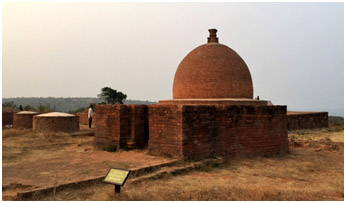 Thotlakonda is located 128 m above sea level and the finds here include mounds, stupas, chaitya grihas, pillared halls etc.
Thotlakonda is located 128 m above sea level and the finds here include mounds, stupas, chaitya grihas, pillared halls etc.
The Buddhist Complex on the hill-topofMangamaripeta, locally known as Thotlakonda lies about 16Kms from Visakhapatnam on Vizag-Bheemili beach road. It is picturesquely located on the hilltop at about 128ft height. The existence of Buddhist site at Thotlakonda came to light during an aerial survey undertaken by the Indian Navy. After its discovery, the Government of A.P has declared the site measuring an area of 120 acres on the summit as protected monument during 1978. The excavations that lasted from 1988 to 1992 have exposed structural remains. These remains are classified as A) Religious, B) Secular and C) Civil. These structures include the Stupa, Chaityagrihas, pillared congregation halls, bhandagaras, refectory (bhojanasala), drainage and stone pathways etc of a U-shaped hill. The remains suggest the presence of brick monastery, a brick stupa and rock-cut sculptures.
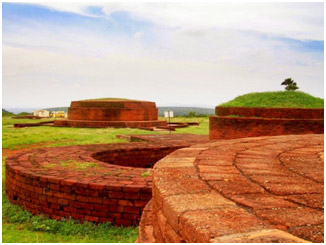 Bavikonda, located approximately 15 km from Visakhapatnam city of Andhra Pradesh is a reputed and significant Buddhist heritage site. A prominent attraction, located in the Sankaram village of Anakapalli, Bavikonda in Telugu means a hill with many wells and true to its name, Bavikonda is a hillock, which has many wells for collection of rainwater.
Bavikonda, located approximately 15 km from Visakhapatnam city of Andhra Pradesh is a reputed and significant Buddhist heritage site. A prominent attraction, located in the Sankaram village of Anakapalli, Bavikonda in Telugu means a hill with many wells and true to its name, Bavikonda is a hillock, which has many wells for collection of rainwater.
Excavations were initially carried out here in 1982-87 which have revealed an entire Buddhist settlement comprising a Mahachaitya that is embedded with relic caskets. A large vihara complex with numerous stupas, a congregation hall, a refectory, rectangular halls etc., were also unearthed. Artefacts discovered from the Buddhist site in Bavikonda includes Roman and Satavahana era coins and pottery that dates back to period from 3rd century BC to the 2nd century AD. A significant finding at this site is a piece of bone, which has been stored in an urn. This bone is believed to house the mortal remains of Gautama Buddha. The urn also has large quantities of ash.
The Bavikonda site is considered to be among the oldest and highly sacred Buddhist sites in Asia. The ruins of this site stand as a testimony to the great Buddhist civilization, which had once flourished even in the southern parts of India. The site, also reminds visitors of the famous Borobudur site in Indonesia. The natural harbours of Vizag area was always considered conducive for dropping anchor, that inturn helped monks from regions like Sri Lanka, China and Tibet to come here and practice Buddhist meditation. Bavikonda is widely regarded as a popular hilltop monastery on the East coast of India that is believed to have hosted more than 150 monks in its heydays, for which massive rainwater tanks were built.
Overnight at Hotel – Vishakapatnam.
Today after breakfast proceed to Vishakhapatnam airport for departure with lots of memories to cherish for a life time!
This is the end of the Trip!
Happy Memories!
